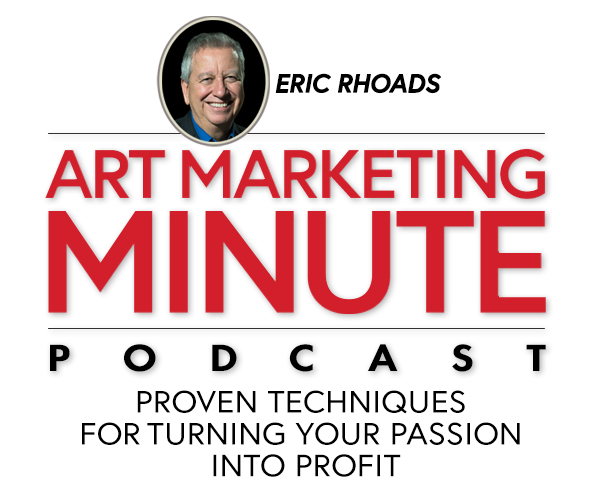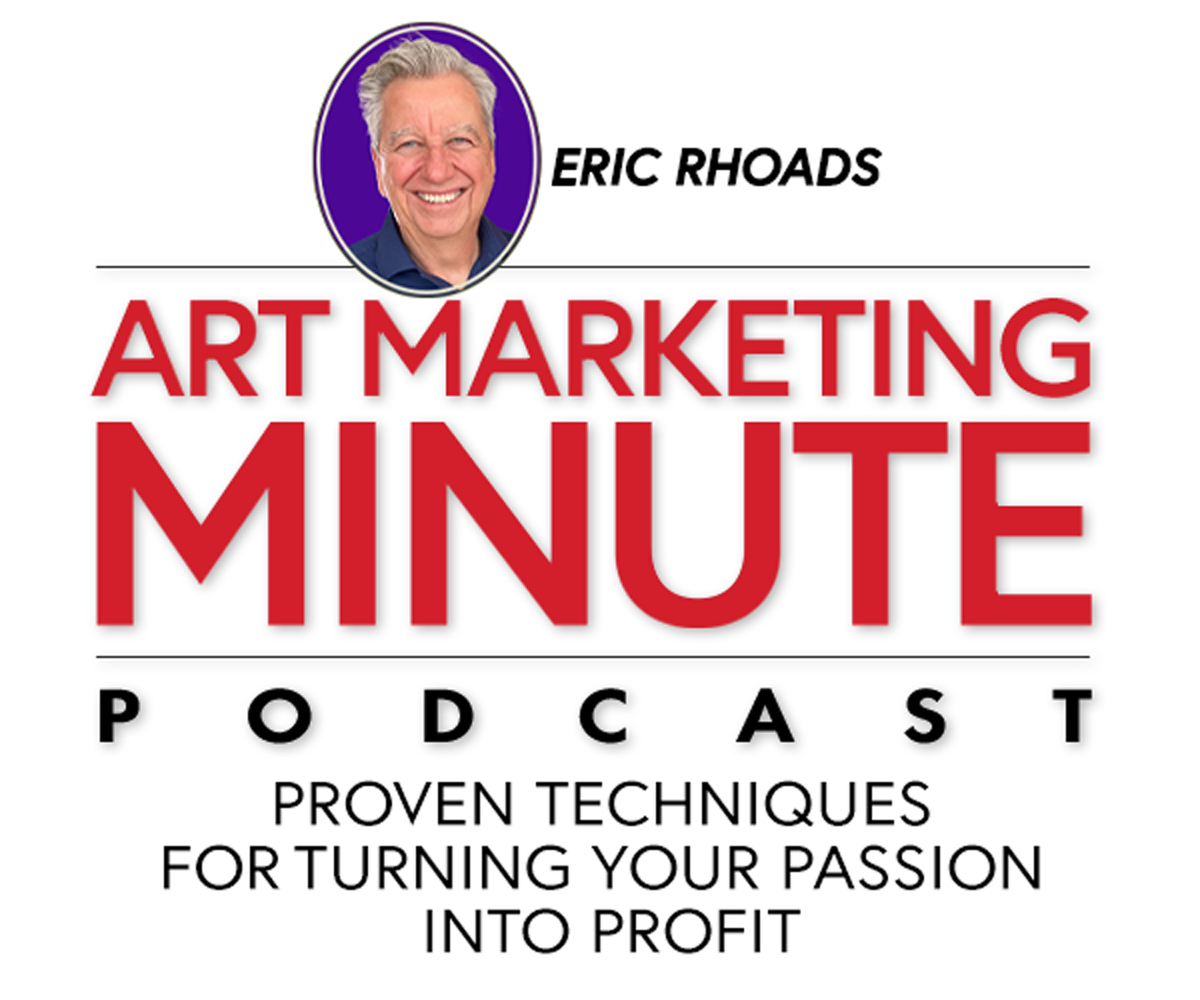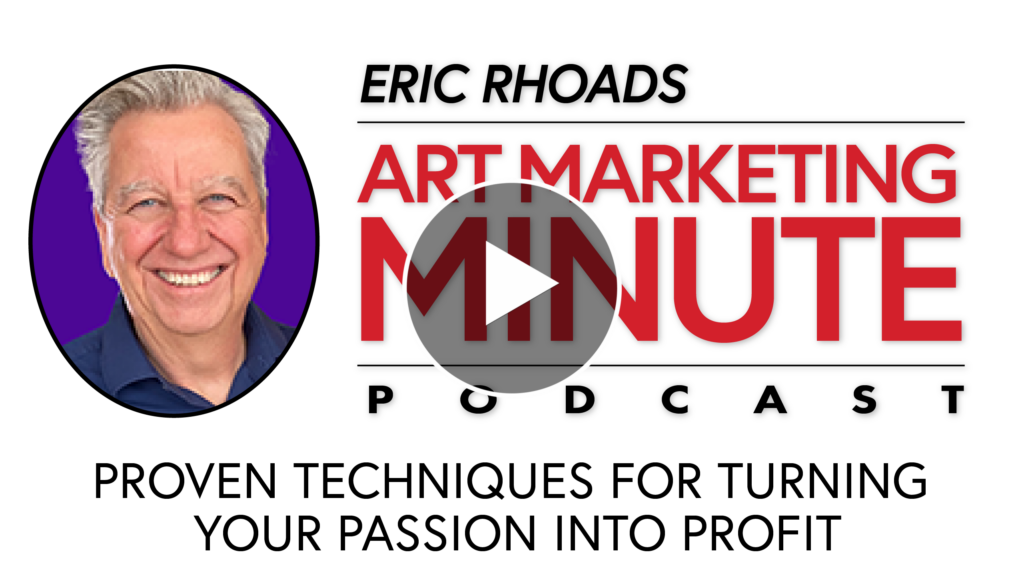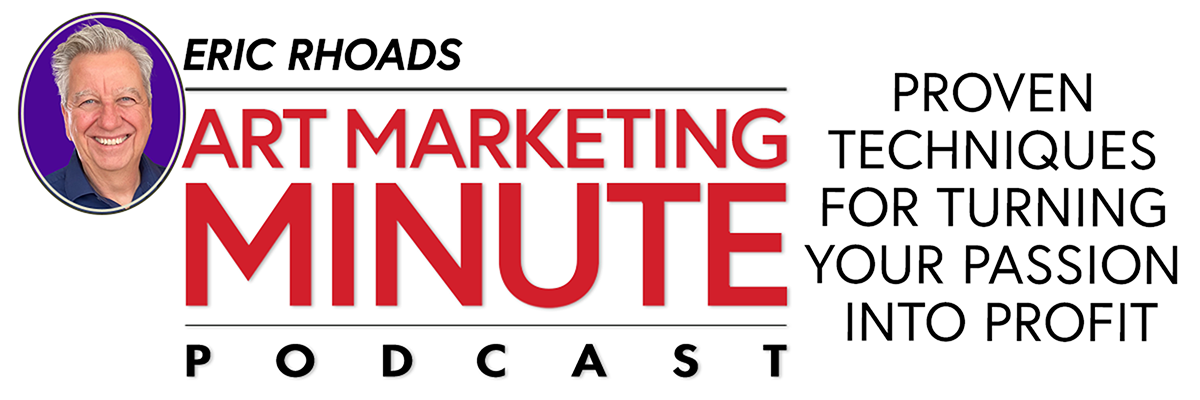Art Marketing Minute Podcast: Episode 100
In the Art Marketing Minute Podcast, you’ll learn how to sell your art, how to market your paintings, and everything else you need to know in order to have a successful art career. Each episode answers questions from artists by host Eric Rhoads, author of “Make More Money Selling Your Art,” publisher of several art magazines and newsletters, and author of ArtMarketing.com.
In this Art Marketing Minute, Eric Rhoads explains what type of paintings you might want to include the next time you enter a work for an art show; and how to beat the odds when you launch an online advertising campaign to sell your art.
Listen to the Art Marketing Minute Podcast: Episode 100>
Submit Your Art Marketing Question:
What questions do you have about selling your art? Email Eric today at [email protected] (include your name and where you’re from) to hear your question answered on an upcoming Art Marketing Minute Podcast.
FULL TRANSCRIPT of the Art Marketing Minute:
DISCLAIMER: The following is the output of a transcription from an audio recording of the Art Marketing Minute. Although the transcription is mostly correct, in some cases it is slightly inaccurate due to the recording and/or software transcription.
Announcer:
This is the Art Marketing Minute with Eric Rhoads, author of the Amazon best selling book, “Make More Money Selling Your Art.” In the marketing minute we answer your questions to help your art career brought to you by artmarketing.com, the place to go to learn more about marketing. Now, here’s your host, arts magazine publisher, Eric Rhoads.
Eric Rhoads:
In the marketing minute I try to answer your questions, your marketing questions, of course, you can email [email protected] with your questions, and tell me your name and where you’re from. This guy didn’t, but we’ll answer his question anyway. It’s a question from Ray Richardson. Ray says, When entering an event for the first time, what type of paintings? Should I include? Landscapes obviously, but what about things like still lifes or pet portraits? Should my work be solely geared toward what attendees expect? Or should I show a wide variety? Since my interest varies? From vehicles to animals to landscapes to still life? Great question Ray. The one thing I think you have to be thinking about is when you’re first branding yourself, and you’re first getting out there, you want to stand for something but don’t stand for everything. You can confuse people by doing showing too much variety. Also, I think the answer lies entirely on the show. Most shows have criteria landscape show typically will want you to show landscapes and nothing else, maybe a figure or a portrait or at least a figure in a in a landscape. But always whatever you do, show your best work, try to get a third party opinion from a pro who can be objective and tell you if something isn’t your best work. Only put your best stuff out there. No matter if it’s a show or it’s online or anywhere else. Editing is important. People don’t understand unfinished paintings unless they’re artists and even then sometimes don’t notice it. They’ll just go Oh, that was awful. So show your best work no matter what. Whether you’re showing in person or online, you only have one chance to make first impression.
Next question, Lisa did this right? She gave her town Lisa Cunningham of Waverly Township, Pennsylvania sounds beautiful. I’m sure it is. Maybe we’ll paint there sometime. Lisa, she asks, I’ve been giving serious thought to launching an aggressive ad campaign, knowing that it will take repeated exposure of my work to yield results. That’s smart. However, I can’t help but think no matter how appealing a work of art might be to a potential collector, it’s still an expectation that they actually see the work in person before making a sale. Galleries in Art Fair satisfy this concept. But as you know, both are very unpredictable and attracting the right buyer. Well, everything’s unpredictable and the right buyer, but you can kind of beat the odds a little bit, Lisa, by going after a concentrated area, you know, concentration is really important. For instance, there are places that have concentrated audiences of people who are known art buyers, and you want people who are known art buyers in the kind of art that you sell. There’s no doubt in my mind that seeing a piece of work in person is best. And I think people need to see artwork, you know, people are seeing a lot of things on Instagram or Facebook, and they’ve never been to a museum and they’re judging it based on what they see. And when they see it in person, it just kind of brings tears to your eyes sometimes. So I think that, you know that would be best. And we all ought to do our best to get people out to see original art, but that’s a sign of the times. And you have to get attention and sell in every way possible. And it’s very common always has been for collectors and others to buy from an image, whether it’s a web image, which is more recent, or a Facebook or Instagram image. You know, galleries have done this forever. You know, they’ve done it from photographs, even they used to send catalogs before the web, and some of them still send catalogs. It’s a very, very normal thing collectors and buyers are very used to it. Photos of paintings have been used. As a matter of fact, I was looking through some old magazines from the 1800s art magazines. They were advertising paintings with etchings, not even photographs. So you know it’s been going on, it’s just not possible for everybody to see it in person. And usually the gallery if they mail it out, and the person doesn’t really fall in love with it, they’ll they’ll take it back, so I wouldn’t be too concerned about. Now let’s address your other question about ad campaigns. Well, I really you kind of had it down, Lisa. But I need to disclose first that I own some magazines that sell ads, but I’ll try to be objective anyway. I learned this a long time ago and I learned it the wrong way because I used to think that you could buy an ad an ad a single ad in a magazine that had a big audience and it would sell something it’s just simply not usually true. It’s usually true for an event or something specific time like that, but not necessarily for selling paintings and building a brand first you have to have repeated exposure. You have to assume that you are unknown and have to become known now you may be known in your town or your region, but you may not be known everywhere. Does Matter of fact, we, we did a thing with a very famous artist. One time we launched one video, we assumed this artist was known worldwide. But in reality, he was only known around New York where he lived. So we had to build a lot of repetition and build his brand before the video would sell. So the other thing is that there are a lot of artists who were once known who have stopped advertising. I know, people who advertised 10 years ago who stopped advertising. And we assume that everything is attrition with 10% of any audience in a single year, in in a bad economy at more might be more than 10%. So for instance, if somebody advertised 10 years ago, assumes everybody knows who they are 100% of the people have never heard of them. So that’s something that they have to be thinking about. So the the best way to overcome all of these issues is to relentlessly repeat, if you’re unknown, or you want to get known. This applies to everything, whether it’s a magazine, email, social media, or otherwise, one of anything typically doesn’t work. Sometimes, you know, carpenters can’t hammer a nail with one slam, usually, maybe have a big muscle, but it takes repetition. advertisings like the law of physics, for instance, imagine a battering ram on a castle door, a giant tree with a big weight and force can break that door down with just a few taps. But the smaller the tree, the more taps it takes, you have to repeat and repeat and repeat because you have to create attention, then get interest, then desire, then purchase. And by the way, if somebody doesn’t happen to like the one particular painting, you got to build your brand so that they know who you are. And then maybe one day, they’ll like one of the paintings, so many of my you know, some people might not buy for years, but that presence over years, builds your brand. I’ve got lots of stories, I’ll tell you some time anyway, the average person needs to see something seven times before they buy it, that means see it. Now, if they don’t see everyone that runs, that’s not going to do you any good. And of course, the average person isn’t going to buy every painting they see. Not even every painting they like. So it depends on how often and it also depends on a certain amount of luck, right? So you lose momentum. If you just do it once, wait a few months and then do it again. You gain momentum. If you do it, for instance, three times in a single magazine or like what advertiser did for us, it was a new gallery, he wanted to get noticed fast, he wanted to look big and important. So they were like the battering ram. They bought 10 full pages and fine art connoisseur in plein air. They ran them, everybody noticed it got a lot of attention. It worked right away. They got a lot of massive action because of that, because they were a big battering ram. So there are ways to overcome things. But they also stayed visible over time, and stayed on people’s radar for several years so that people would know who they are interesting. Once they got to the point where they felt really confident that everybody knew who they were. They stopped advertising everywhere. Within two years. They were out of business. I don’t know if there’s a correlation. But just saying right, so my best advice. Don’t do ads if you can’t repeat them a lot.
Well, this has been the art marketing minute with me. Eric Rhoads. My goal in life is to eliminate the idea of the starving artists to help your dreams actually come true. So if you want to submit questions, simply email [email protected]. And to learn more about marketing ideas, you can visit Artmarketing.com. Thanks for listening.
How to Submit Your Art Marketing Questions: What questions do you have about selling your art? Email Eric today at [email protected] (include your name and where you’re from) to hear your question answered on an upcoming Art Marketing Minute Podcast.
> Visit EricRhoads.com (Publisher of ArtMarketing.com) to learn about opportunities for artists and art collectors, including:
- Art retreats
- International art trips
- Art conventions
- Art workshops (in person and online)
- And more!



